
This post is only available to members. You register for FREE here or login if you are already a member

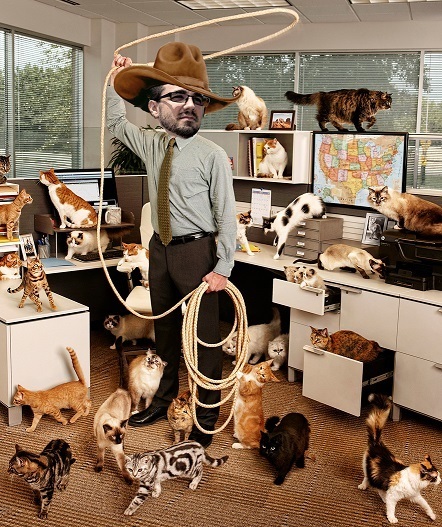
Soundtrack for today’s RoundUp pessimist readers- http://bit.ly/37Tb3lU (bonus- http://bit.ly/3a5us4U)
For optimist readers- http://bit.ly/2R8eyOK
We made it to 2020. Where are the flying cars?
THIS ONE GOES UP TO 11! Come hang out at the 11th annual Medicaid Innovations Conference in Orlando in February. One of my favorite events (it must be- I’ve been to all but 1 of them over the years). Check out the agenda and sign up here- https://www.medicaidinnovations.com/agenda.html
ANDY, ANDY- SO FINE AND DANDY- HOW DOES YOUR BUDGET GROW? Continuing our coverage of the Good Guvn’r Cuomo’s Adventures in Bad Leadership this week. Andy announced a 1% cut to Medicaid providers on New Year’s Eve (Happy New Years, Suckers!). That cut will be for 90 days and will save about $126M. Sounds cool until you realize that just the Medicaid budget hole is $4B. Andy also promised a plan to deal with the overall deficit back in December. Part of that plan appears to be cooking the books again by delaying about $1.7B in Medicaid payments so that they appear in the next FY (He also did this last year, but secretly). We all wait with baited (bated?) breath for the new plan. Especially officials (and taxpayers) in the counties of NY. Cuomo’s recent state of the state hinted at increasing the share counties chip in to cover the costs of unfettered Medicaid spending. Innovation abounds in the legislature as well: the brilliant Dems in the statehouse want to “address the deficit” but without “cutting services.” I would also like to lose weight by eating cookies. Idiots.
NEW WAY TO GET A DO-OVER ON AN MCO BID? ELECT A NEW GOVERNOR, OF COURSE- If you lost out on the latest KY bids, dust off your proposal. Beshear- in his effort to undo all things Bevin- has ordered a do-over on the latest contract awards. Is that even legal? Is “legal” even a thing anymore?
MOLINA BACK ON THE WARPATH- The MCO will purchase NextLevel Health for about $50M. The buy will give Molina a strategic path to increase Illinois Medicaid revenues.
CMS TINKERING WITH 340B AGAIN- This time CMS is taking aim at duplicate discounts (that hurt Rx makers by hitting them with having to pay discounts in both 340B and the Medicaid Drug Rebate Program; MDRP). The federalis released a guidance bulletin Jan 8, outlining what The Big House views as best practices. Basically, the recommendations focus on using data to avoid overlaps, writing better contracts and limiting covered entities. Initial opposition was summarized as thus: These are great ideas, but it will make it harder for us to keep the federal money flowing. Doing the right thing is too costly.
YOU HAVE A FEW MORE WEEKS TO TELL CMS HOW MUCH YOU HATE CHANGES TO SUPPLEMENTAL PAYMENTS REGS (BUT DON’T MAKE IT TOO OBVIOUS HOW SELF-INTERESTED YOUR OPPOSITION IS)- I think the gist is best gleaned from a recent quote by CMS Administrator Veerma: “We have seen a proliferation of payment arrangements that mask or circumvent the rules where shady recycling schemes drive up taxpayer costs and pervert the system.” Supplemental payments to skilled nursing (and other) facilities now account for $3.5B each year (about 7% of all Medicaid FFS spend)- but when these payments are passed through the managed care model, CMS has very little idea what they are actually paying for. Feb 1 is the deadline to weigh in on the proposed rule. The rule establishes new reporting requirements about what states are doing with the payments.
KANSAS HOPS ON THE EXPANSION TRAIN- The Good Guvn’r Kelly announced plans to take the free federal money last Thursday. The Kansas expansion plan will seek to get additional funding for services for the thousands of severely disabled members who have been on the waiting list for years. Just kidding – I am sure it will all go to comparatively healthy 20-year olds who don’t want to be forced to work to pay for their own “coverage.” To be fair to KS, they have cleared their waiting list in the past. Not all states (and certainly not expansion ones) can say the same thing.
$2.6B IN 2019 FRAUD RECOVERIES LAUDED BY DOJ. SOUNDS GREAT UNTIL YOU REALIZE CONSERVATIVE ESTIMATES PUT CARE/CAID FRAUD AROUND $100B EACH YEAR- Read the latest annual report here. It is getting better. Long way to go. Very long way.
FARRIS’S FANTASTIC FRAUD FOLLIES– And now for everybody’s favorite paragraph. The paragraph taxpayers love to hate. Let’s start the ticker and see who wins this week’s award. Just a few tidbits this week, dear readers (it is just the first full week of the year, after all). Lets first go to Balmore (Baltimore), where we find someone murdered over Medicaid fraud. This one doesn’t have a dollar amount, but I wanted to share it with you to show you how pernicious and evil Medicaid fraud is. Latrina Ashburne, a teacher’s aide, was murdered (allegedly) by Devon Carter and Clifton Mosby. The broke into her home and shot her, thinking she was a Medicaid fraud whistleblower in a case against a friend of theirs. Lets head north for some less lethal Medicaid fraud. In Danville, New Hampshire we find Richard Gaudette. Mr. Gaudette was sentenced for stealing $111k in Medicaid bucks using a personal care services scheme. He billed for services even when his clients were in the hospital or dead. For our last entry this week, let’s head west, way west- all the way on over to Alaska. We find John Zipperer in Wasilla, where he operated a $9M scam using unnecessary tests. He ran over 1M (or claimed he did) tests on urine samples using a lab he owned in Tennessee. His $9M scam was 10x the total amount that all other providers in Alaska were reimbursed for the same tests. Wow. John Z- you win this week’s award! Taxpayers, you of course lost, yet again.
That’s it for this week. As always, please send me a note with your thoughts to clay@mostlymedicaid.com or give me a buzz at 919.727.9231. Get outside (finally get those leaves up if you haven’t. I know I haven’t. ) and keep running the race (you know who you are).
FULL, FREE newsletter@ mostlymedicaid.com .
Trystero: پدر پسر را فرستاد تا دنیا را نجات دهد

And now its that time.
We review another 12 months of the Medicaid industry together. And I also attempt to share what has been going on in my life for the past year.
If you have missed the last 3 of these, here is a link. (Hint- each icon in the section breaks represents one of the years in reviews. Not sure if that’s how you pluralize that. Sort of like how toothbrushes works).
So glad you are here this year, all my reader friends.
Let’s review all the work / industry stuff first.
Let’s do this in memes.
Yes- you read that right. We are going to review Medicaid 2019 in memes.
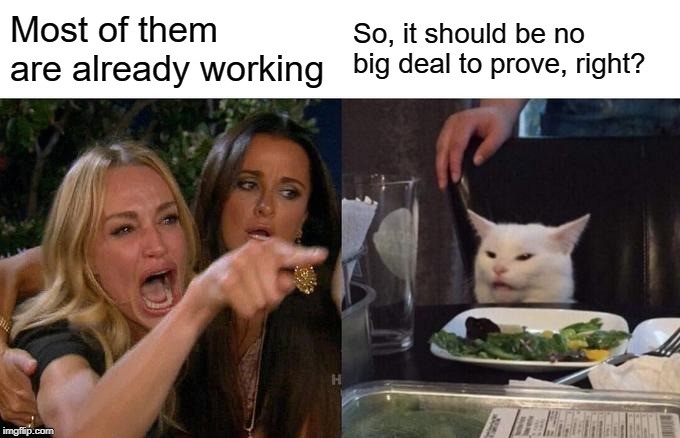
Work requirements carried over as an issue from 2018 and the update for most of 2019 was “lawsuits are pending.” I think for me it mostly got tiring hearing lefties monolithically argue against work requirements using one of the 3 following canards:
So here’s my answer to all this nonsense in the form of a meme:
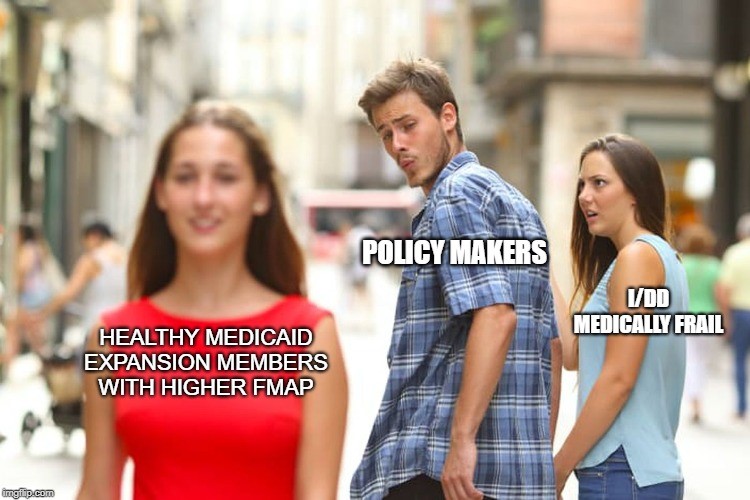
See the thing is – the thing no DoubleSpeaking expansion advocate (work requirements and expansion are inextricably linked) will let you notice – is that healthy, able-bodied Medicaid members who got added under expansion bring lots more (90-100%) federali money than the traditional aged, blind and disabled (you only get regular ole’ federali cash for those folks, usually between 50%-75%). Its not the altruistic pretty picture expansion zombies would have you believe. Its cash, cash, cash. Screw the disabled so that healthy adults can get a Medicaid card. Screw that, I say.
And of course, there are a few intellectual contortionists who came up with junk analysis to say expansion doesn’t hurt traditional Medicaid members. Don’t believe them. If you are a state budgeteer and you can get 100% federal money for one population, or have to come up with millions more in state funds to increase services for another population- what are you going to do? And please, please, please don’t trot out the “free federal money” argument to pretend you can have sufficient money for both ABD and expansion, too. If I hear that nonsense one more time I just might throw up in my mouth.
I have decided that waiting lists are the absolutely most clear condemnation of Medicaid expansion possible. Get the tens of thousands of truly vulnerable off the waiting lists in states across the nation – then I will listen to you boo-hoo about work requirements. Until then – I have to work for my own healthcare coverage, and I think anyone who can work should have to, too.
2019 was the year Medicaid spending didn’t go up. All these innovations around value-based payment have finally started to pay off. Just kidding! (or psych! as we used to say in middle school in 1989).
We saw another round of budget crises in nearly every state this year. And it was the same script in 2019 as it was in 2018 as it was in 2017… In order to keep services the same, and not have the sky fall and kill all the children (of course), every statehouse heard the plea for more, more, more. Some states- like Alaska- actually tried to tighten the belt. Guess what happened there? You guessed it, a judge ruled that Governors actually don’t have any power and allowed the provider lawsuits needed to “restore cuts.”
So here’s the conclusion I have come to. Price is the issue. Not cost. Price as set by providers. As differentiated by what it costs to make a product (or provide a service) versus what the merchant charges for it (price).[1] If we don’t address healthcare price- which absolutely has been on a cocaine-fueled, skyrocketing joyride for nearly all of recent history- no amount of policy smoke and mirrors (“innovation”) will ever put a dent in it.
And the scariest thing to me about price is that I don’t think there is a single example of anything (i.e. student loans, housing) that is subsidized by the government ever NOT having nightmarish price trends. Its almost as if the merchants say – “Hey look, the government has to buy it, and we get to set the price, so why not set it higher and higher and higher?”
[smartslider3 slider=2]

And now for the personal / life stuff. Thanks for letting me wrant (I just made that word up- its when you rant in written form) about the Medicaid industry stuff.
NOTE [1] Don’t believe providers who tell you they are losing money on Medicaid. Once we have actually data on costs, or until we have at least more price transparency, the black box of provider “costs” is simply a tool to allow the merchants to charge uninformed buyers whatever they want. And make the buyers feel guilty for pay “so little.”

Let’s set up the overarching analogy first. The thing that will make this globby read stick together.
____________ is what you play and when you play it.
You can fill in the blanks, but any musicians out there with a lick of theory will know that Music goes in that blank nicely.
I heard it from Earl, my very first guitar instructor when I was 19 years old.
“Really, Clay – music is just what you play and when you play it. The notes are the what, and when you play them is as important as what you play.”
I think this applies to just about all of the human experience. Let’s run with it.
This year’s disclaimer: For some reason – I think its because I write these things in December, which is a reflective time, and reflection is almost always somber, or at least not chipper- my Year In Reviews (we are up to 4 or 5 now, I think) tend towards bittersweet. I am not sure why you people keep reading them, but you do (based on all the wonderful notes I get each year), so I will keep writing them. And honestly I probably would write them whether or not anyone read them.
But thank you for reading. Please write in (clay@mostlymedicaid.com) with any reactions you have.
This year is bittersweet, too. But not as much of a tear-jerker as last year.
And it includes football, and old people, and hymns, and dogs and graveyards. What’s not to love about that?
Taxes are still a thing. If only I could select what they went to (like a sushi menu), I would gladly pay more. As it is now, I resent them and look for all legal ways to minimize them. I guess if the only real con I can think of for a whole year is that I have to pay taxes in the very best country that ever existed on the face of this planet, 2019 really wasn’t bad at all.

One of the very best decisions I made in recent years was to go into nursing homes and sing old hymns to the residents. Correction- with the residents.
My first few gigs were in 2017. I loved them so much I scheduled standing gigs in 2018 and this year I played 48 gigs. The value of those moments with elderly believers worshipping God is incalculable. I have cried so many tears of joy singing with them. At least once a month my voice cracks up as I sing Great Is Thy Faithfullness. Or Victory in Jesus. Precious Lord is the real crowd pleaser, and for me it is tied with Because He Lives and Precious Memories. Who am I kidding? I love all of these songs, nearly equally well.
Go into a nursing home the first Monday of every month and you make friends. They start to look for you. And you for them.
[smartslider3 slider=3]
Mr. Brown (not his real name) taught me a whole new verse to Amazing Grace. One that is not in my 1975 Baptist Hymnal.[2] But first let me tell you about how I met Mr. Brown.
I and the older 2 kids (they LOVE seeing children. And I finally learned when I bring the kids to just put them in front of the mic. The residents do not care what I sound like at that point) had just finished playing. There were maybe 20 residents there (which is a huge gig for us). We were packing up the gear, and Mr. Brown asked if he could have the mic.
At first I hesitated. This hadn’t happened before.
What was he going to say?
He didn’t say anything, but instead starting
singing.
Let me back up a minute and describe Mr. Brown so you have a picture of him. Not that his appearance matters, but just you can visualize him. And maybe so I can, too. Years later when I read this again, like I obsessively re-read things I wrote years and years later.
Mr. Brown is in his early 80s. He is about 5 10 (I’m just guessing- Ive only every seen him sitting down). About 300 pounds. Wears sweatshirts and jeans and a ball cap. His smile – though missing a few teeth- is on my top 10 smiles of all the ones I’ve seen in my life. Mr. Brown is also black- but from a time where calling him “African-American” would be as weird to him as it is to me.

After I got to know Mr. Brown over the course of a few months, he was sitting out on the front porch while we were loading in. Loading in from out of my 1996 Blazer (I have a thing for old run down cars and keeping them running. There’s an analogy for me in there somewhere. Maybe underneath the catalytic converter). That Blazer was a gift to me from my father in law when we were just starting our family. And at that point it was 10 years old. But it was huge blessing.
I can not see myself getting rid of it. Ever.
But Mr. Brown remarked that it was a nice car. And I agreed, but also thought to myself that most people would not think so. I can almost guarantee you that the majority of people reading this consider a Lexus a nice car. Or a brand new Pilot. Or maybe – maybe- a new Camry. But not a 22 year old blazer with 150,000 miles on it.
But I kept my thoughts to myself. And I’m glad I did, because it gave Mr. Brown space to continue.
“I never had no car. That’s a nice car.”
In that moment I knew my appreciation of the blessing of this old car was insufficient. That I had any car at all was such a blessing. Mr. Brown had lived 80 years and never had a car.
Back to that secret verse of Amazing Grace you may not know about.
Once I hand him the mic, Mr. Brown started singing two words over and over, to the melody of Amazing Grace:
Praise God
Praise God
Praise God
Praise God
I had never heard this done.
It was so powerful. And the other residents all sang along. He was their leader and I knew in that moment he played an important role in that community of aging, dying believers. Day in and day out he was there. Encouraging them with his toothy smile and loving words. I was just there for an hour every 30 days.
From that moment on I looked to include Mr. Brown however I could.
But I didn’t get many more chances. He was there maybe 3 more times. I asked the activities director if he was ok for a few months. She would always say he was just tired.
Now I haven’t seen him in nearly a year, and I fear he is gone (dead). I think the activities director wanted to spare me the sadness because she could see how fond I was of him.
But that’s the gig in these gigs – you are playing (and bonding with) to an audience not long for this world. I often wonder how people who work in nursing homes are not crying every day. Maybe they are.

There are so many people I want to tell you about from these gigs. But let me share just a few more.
There is a lady in the memory care unit of one of the places we go. If you have never been to a memory care unit, the important thing to understand if that these residents are an elopement risk. Many of them wear anklets that are paired to alarms near doors so staff know they may be attempting a break out. There is a wide range of memory issues seen in these units, but in general the very mildest cases are what you would consider “severe” from a lay person’s perspective.
What I noticed early on with this population is you need a different set list. You need older songs. Instead of hymns from say 1940-1960, you need ones from the late 1800s (those songs are what their parents taught them as young children). They know hymns from both time periods, but the older ones resonate with them much more deeply (think Blessed Assurance vs His Name is Wonderful). But the really beautiful thing is that these residents may not know their children’s name (of course that is sad, but wait for the concluding clause)- but they remember all the words to How Great Thou Art. And they light up when they sing it with gusto.
I am very impressed with this particular facility. Not all of them are as compassionate as you would hope. Or maybe the word is not compassionate, but rather thoughtful. This facility does things like buy a jukebox with pop songs from the 1950s in it. And they put cribs in one of the common areas, complete with baby dolls in them. You may think that’s strange. I did at first, too. But then I saw how soothing it is to some residents. And I was thankful that the staff are working to meet the residents where they are in their journey.
I have heard nursing homes referred to as “Heaven’s Waiting Room.” I think there’s a lot of truth to that. When I first tell people (people not in nursing homes) the songs I sing, they are somewhat shocked. Because all the old hymns pretty much talk about death. And about looking forward to it as the only way to reunite with our Savior. That last part is key.
But what I noticed is that the residents don’t mind. Not only do they not mind- they are encouraged by it. Sometimes not just encouraged, but emboldened.
And so am I.
Which is one of the reasons I love “When We All Get to Heaven” so much. I tell them it’s a marching song. And they love that.
But back to this lady in the memory unit.
Most times she is completely silent and sits there and cries while listening to us sing. Sometimes she mouths a few words of the song. Lately she has actually spoken a few sentences and smiled.
Normally her daughter (I assume its her daughter) is there when we play. I think she comes to visit on her lunch break. And I am so grateful that someone has a child that still comes to visit. Almost none of the residents have that. But that daughter comes to see her mother regularly – Praise God.
When the daughter is there, she stands behind her mother (who is sitting on a couch) and leans in to place her cheek on her mother’s cheek. And they just share the time together like that. For an hour. Sometime the mom cries. The daughter only ever smiles. She has never said anything to me.
That woman did something right when she raised that daughter.
At that same facility is another lady who without fail asks my oldest son if he has a girlfriend. Like at least 20 times. From the time we are setting up the mic to when we break down. This is how Caleb remembers this place.
“Is this the one where the lady asks me if I have a girlfriend?”
“Yes, son.”
At first I think it may have bothered him a bit, but now he understands. And he is nothing but sweet and answers her question every time.
“Do you have a girlfriend? How old are you?
“No, mam. I am 9.”
“You sure are handsome. You’re gonna have lots of girlfriends.”
“Thank you, mam.”
Repeat that about 20 times.
She asks Nora if she has a boyfriend. The exchange plays out similarly, but when Nora tells her no, the lady adds: “Well, you are smart, then.”
NOTE [2] I have the Broadman Hymnal as well somewhere in this old house. Its red and smells like wood, carpeted pews and maybe holy water. But of course there’s no holy water in a Baptist Church so maybe my smell-brain is confusing memories…

A few quick others.
One lady, wearing a bright read sweater and hair all done up (it humbles me to tears that they think my songs are worthy of dressing up for) called out once-
“I have a testimony!”
Having learned to not hesitate after the Mr. Brown incident, I told her by all means to go ahead. And she gave a few minutes of her testimony[3] and it is one of the treasures I carry with me in my heart.
My last example is the lady who always thanks me for reading Scripture during the set. I think we assume there are people going in and ministering to these people all the time, but that may not be the case. She seems like she has been starved of hearing Scripture spoken each month. And so grateful for me simply reading from the Psalms.
I don’t know that playing these songs ever would have occurred to me when I was younger. But I learned them all before I turned 12.
It’s what you play and when you play it. Now is the right time to play these songs for these people. The nursing homes may be Heaven’s Waiting Room, but those folks need music, too. And if I can be a part of singing them into heaven, then I am blessed beyond measure.
[3] For those of you who didn’t grow up in a protestant church, this is when people share either their personal salvation story or something God has done for them in their lives.
If you are not familiar with the national wreath laying program for our veterans laid to rest in national cemeteries, it’s a wonderful event where families and friends of our lost heroes gather to lay a wreath on their graves. It happens every year in early December. You can find out more at https://www.wreathsacrossamerica.org/. I highly recommend you participate at least once.
We went this year (and have each year so far since Daddy died and was buried at the national cemetery in Alabama). We are always amazed at how many new headstones there are each time we visit.
What struck me most this year was that the living have basically made the graveyard (cemetery, I guess, since not attached to a church- but there is a chapel, I think) a part of their life. By that I mean they place everyday items that mean something to them (and I assume to the deceased) at the tombstone. We were accustomed to the coins left on headstones (learn what that is all about here). But there are also very specific rules about what can be used as decoration, and I think we saw lots of violations that day. My guess is the groundskeepers look the other way around Christmas to help the grieving make it through another December without their daddy, or momma. Or daughter, or son. Or best friend.
[smartslider3 slider=4]
Looking at what the grieving choose to leave is eye-opening. In a good way. It shows you that not only does life go on after the burial, but it includes the one buried. Some objects are very specific to that family (like a sea shell or a snow globe). Some are sports teams- we found 2 Alabama Crimson Tide items, and are in the process of making sure we get some Auburn ones in there soon.
To me this shows that there is life in the graveyard. It shows me that the people buried there played the right things and played them at the right time. They left an impression- a good one. They are missed but in no way forgotten.
You should participate in a wreath laying sometime. Here’s that link again – https://www.wreathsacrossamerica.org.

We took the kids and Momma to see the Christmas lights at Callaway Gardens this year. This is another thing I recommend you do at least once- its actually on various lists of top 10 lights events in the world.
On the way back home from Callaway, we stopped in Auburn (see last year’s Year in Review for a similar pilgrimage). We checked out the new Arena first (the basketball facility). And it was cool.

In it I found this quote on the wall:
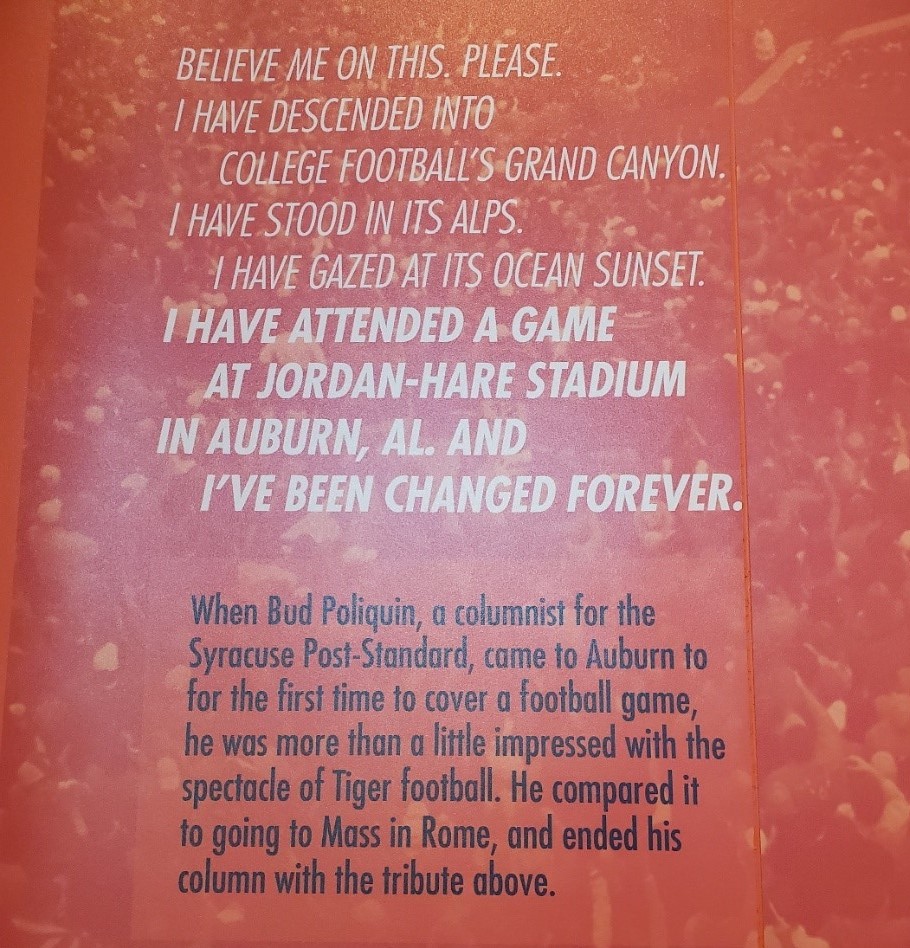
That quote says it pretty well, I think.
As we were leaving the Arena, my oldest asked to go over to the football stadium. As we also did in last year’s escapade, we snuck in.
Once inside, it all took care of itself.
We were in the right place at the right time. What you play, when you play it.
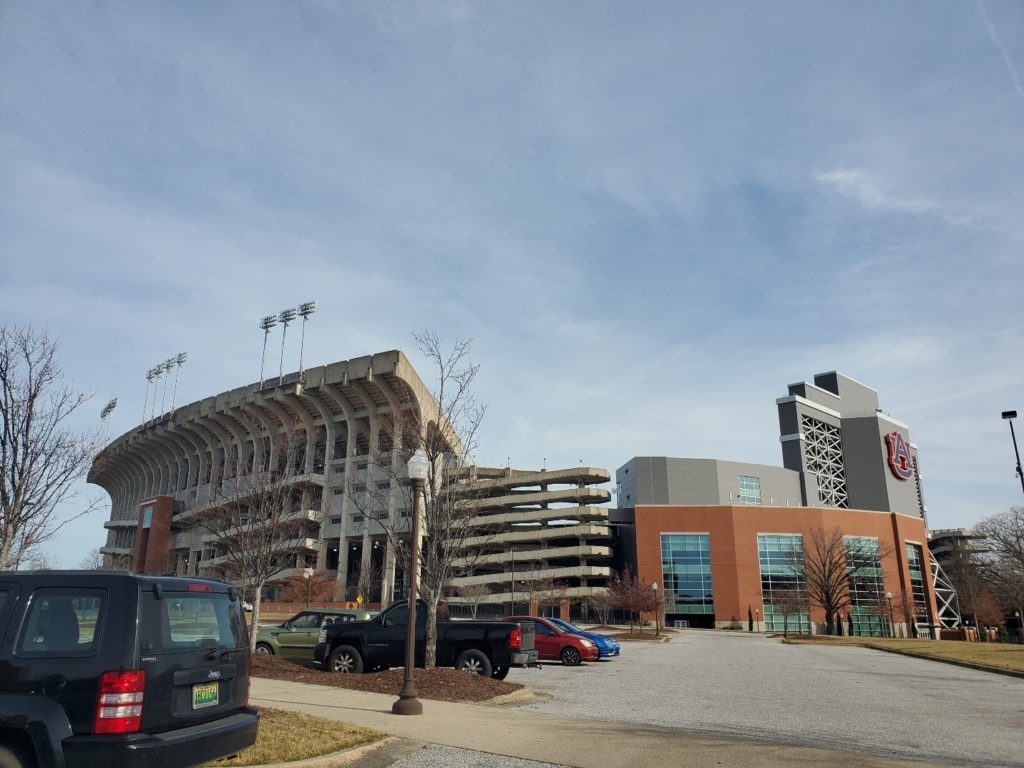
We made our way, like salmon back to where we were spawned, to the field. Anyone who was ever a teenager knows its cool to get into places when you’re not supposed to. None of that high school mischief compares to standing on that grass at Jordan-Hare Stadium. And stand on the grass we did.
And we took pictures. And remembered the amazing game where we beat nasty Alabama just a few short weeks before. It was an astonishing game and if you watched it and didn’t like it, then you don’t like football and I can’t help you.
We got into an open construction entrance near section 44. We made our way down about 25 steps or to that little gray gate in the corner of the endzone. It wasn’t locked. We were supposed to be there.
The kids and I took pictures. Walked over spots we knew those Auburn Tigers had run over with amazing skill just recently. To beat Alabama. (Praise God)
And quietly Nonna walked 100 yards to the other side of the stadium to the other endzone.
Where she and my dad had sat together in the same seats for decades. Where their season tickets had been. (We lost my dad 2 years ago).
And she just sat and looked out over an empty stadium. Staring across a lifetime. Back from when she lived there as a young wife with my Dad in the early 1970s. When he went to school, coming off a stint in the Navy to pay for his degree. Back when she and he attended games in this same stadium but in the student section, instead. I am sure much crossed her mind as she sat there and stared on this beautiful December day in 2019 some 40 odd years later than all that long, lost time. But this time she was alone, without her Bill. And he without his Preppie.
[smartslider3 slider=5]
Jordan Hare stadium has seats for about 86,000 people. If its sold out at halftime the will let in another 20,000 or so to stand in the ramps that lead to the upper deck. You then have a gathering of people – all there because they love Auburn and know it is the very best a college or town either of those things can be- that is bigger than most cities in the world.[4]
But that day there were only 7 of us in that stadium. And as momma sat on the cold, metal stadium seats, to her there were only 2. I cannot fathom the feelings of both emptiness and fullness of heart she must have been feeling.
Yet there was life in the stadium that day.
As kids we had season tickets about 2,000 feet in the air in the upper deck. My kiddos saw these upper seats towering above us and were amazed. ‘Can we go up there, Daddy?”
Trying to say yes more these days, I said “As long as we can find a working elevator.”
And we did. Pretty quickly. We were meant to be here this day.
God was opening stadium gates and turning on elevators.
Once we got to the upper deck, I walked the kids about 70 steps or so to the very top.
“We are as high as the birds,” Nora said in awe as a group of pigeons flew level with us about 4 sections over.
After a few minutes up there, we descended back down to the bottom of the upper deck to head home.
We got back to Momma (Nonna) and Stacy (Momma). “Its time to head on,” I said. They had been talking about who knows what while I and the kids journeyed to the upper deck and back down.
And a few minutes later, two police officers walked up to us from behind that little tunnel area where you walk into the stadium from the corridor where the concessions and bathrooms are.
I smiled at the officers and turned back around to look at the stadium again, committed to acting like we were supposed to be there.
“The stadium is closed.” The officers words came from behind me, and I turned around and smiled.
“Yes, sir. It’s time to head on kids.”
“Are you guys from around here?”
“No, sir. Well, my mom’s husband – my dad- went here. And so did my sister.”
“There’s just some construction going on in the stadium today, but no one is supposed to be here.”
“Thank you, officer. We will head out now. Please remind me where the elevator is.”
We made our way down the elevator and back down to the ground floor. The officers were walking about 100 feet behind us to make sure we left.
And we did.
On the way out my oldest daughter asked me if I had ever been arrested.
“No, Nora.”
“Well have you had a lot of interactions with the police? You seem to know what you were doing speaking with them.”
“Those are stories for another time, honey.”
Life is what you play, when you play it.
Thank you officers, for letting us play that day.
NOTE [4] To give a little more perspective – those 2 numbers together around about 100,000 people, round figures. Shakespeare’s London had about 200,000 people in it. So imagine about half of all Londoners going to see Hamlet, screaming their lungs out, grown men crying tears, women jumping for joy- for about 3 hours straight. And that’s an Auburn football game. Except you can understand all the words, because it ain’t the Queen’s English.

I want to leave you with encouragement.
I want to remind you one last time- Life is what you play, when you play it.
I want to wish you this:
When you enter old age, may you have visitors every day. May the graveyards of your kinfolk be filled with mushy trinkets and singing. May your empty stadiums overflow with Precious Memories. And may whatever demons you tilt at turn out to just be windmills after all.
Here’s your assignment- Find something to do consistently (and monthly) that brings joy to strangers and do it 12 times next year. It will change you. Vets are a great target market for this. So are the elderly.
2020 is your year.
Go play something awesome. Play it loud. Make your voice crack. Break a sweat.
Report back December 31st, 2020.
The thief comes only to steal and kill and destroy; I have come that they may have life, and have it to the full. John 10:10 (NIV)

Soundtrack for today’s RoundUp pessimist readers– http://bit.ly/34fvYO3 (kind of can’t believe this one has never made into the Roundup in all these years. Something we all need about now as we do our umpteenth Christmas party. I also used to do a solid Axl Rose impression in high school, with this one at the top of the set list)
For optimist readers- http://bit.ly/2LP0zvd (this song will grab your heart, and warm it like a wood fire. Or a cup of cider. Or the last hug you got from that lost loved one, when you didn’t know it would be the last one. It’s a REALLY good song, even though its basically sad).
THIS ONE GOES UP TO 11! Come hang out at the 11th annual Medicaid Innovations Conference in Orlando in February. One of my favorite events (it must be- I’ve been to all but 1 of them over the years). Check out the agenda and sign up here- https://www.medicaidinnovations.com/agenda.html
NOT SO FAST ANDY BOY- Stop1 in the Cuomo Medicaid Malarkey Tour: shady deals where you slide big ticket spending out of one fiscal year into another to hide Medicaid spending growth that exceeded the legal limit. Stop 2: pass a hospital gravy deal after they donate boucoup cash to the Democratic Party coffers. Stop 3: Go into damage control mode and do lots of provider cuts real quick-like to cover your tracks. Only problem is that the state Comptroller is on to your schemes, Andy. And he’s asking you to provide more info about the cuts you say will magically deal with the $4B over-run. Looks like maybe you actually got caught this time? Should we get a FISA warrant?
MOLINA JOINS BLUEGRASS STATE MCO ROSTER- Chalk up another win for a Medicaid plan that many thought was on the ropes this time last year. Molina 2.0 (this time with less Molinas) just won an MCO contract in KY. Go live is July 1, 2020. Congrats to all our friends and readers at Molina.
PASSPORT KICKED OFF HOME FIELD, WHAT NOW EVOLENT? But not so good news for longstanding KY MCO incumbent Passport. Passport lost out in the official agency review process. This one could get interesting though (seems each of the MCO awards have their own flavor of jacked-up these days)- the legislature is ticked because they were given the contracts after the award. And the incoming Governor Beshear (continuing the Beshear dynasty after a brief pause- his daddy was Governor 3 Guvs before) is also promising to review the contracts. So there may be some golf course opportunities the next few months. Or at least until July 1, 2020. This news is particularly troubling for Evolent who just sunk $70M into Passport to help the flailing plan meet financial solvency requirements going into the bid.
NEW YORK HAS HIGHEST NUMBER OF MEDICAID INELIGIBLES ON ROLLS– A new study out of George Mason U out estimates that as many as 3.3M working age adults have incomes too high to be eligible for Medicaid, but are enrolled anyway. This data point (enrollees who should not be enrolled based on income) increased 80% between 2012 and 2017. What else was going on then?
MEDICAID EXPANSION RATE CELLS MAY HAVE LED TO $75B IN OVERSPENDING- No one really cares though, because its free federal money. You know, paid by those federal taxpayers (not you of course, so nothing to see here. You don’t pay any federal taxes, right?). In a story related to the NY one above, other news items focused on the national impact of increasing the enrollment streamed to ACA/Expansion rate cells. Basically, the human behavior you would expect to happen happened in expansion states– pay 100% of costs for members in a certain (new) eligibility category, and states were not quite thorough in who they put in those buckets. If you took an Econ 101 class before the downgrade, this would have been covered in the lecture on moral hazard.
FARRIS’S FANTASTIC FRAUD FOLLIES– And now for everybody’s favorite paragraph. The paragraph taxpayers love to hate. Let’s start the ticker and see who wins this week’s award. We absolutely have to start with the Hoverboarding dentist. Seth Lookhart in Alaska was filmed extracting a tooth while riding a hoverboard. This idiot texted it to 8 people and it got passed around from there. His crimes? Not hoverboarding, but rather stealing $25k from Medicare and $10k from AK Medicaid with unnecessary procedures schemes. Technically he doesn’t meet our $50k threshold for the follies, but I just knew many readers would be sad if they did not learn of the Tale of the Hoverboarding Dentist. Or as I like to call him – The Floating Filling Fixer. Let’s head back east to Vero Beach, FL where we find a pretty big ($1M) personal care attendant scheme. Marie Isaac was the latest to be charged, but there were 19 PCAs who falsified time sheets to get more Medicaid bucks. In Isaac’s case, she sometimes billed for 6 hours of service a day, but her patient testified she never was there more than 45 minutes. Slow fraud week this week folks. I guess fraudsters have tons of Christmas parties keeping them otherwise occupied, too.
That’s it for this week. As always, please send me a note with your thoughts to clay@mostlymedicaid.com or give me a buzz at 919.727.9231. Get outside (get some good firewood if there’s any left in your area. Fires heal.) and keep running the race (you know who you are).
FULL, FREE newsletter@ mostlymedicaid.com .
Trystero: Отець послав Сина, щоб спасти світ
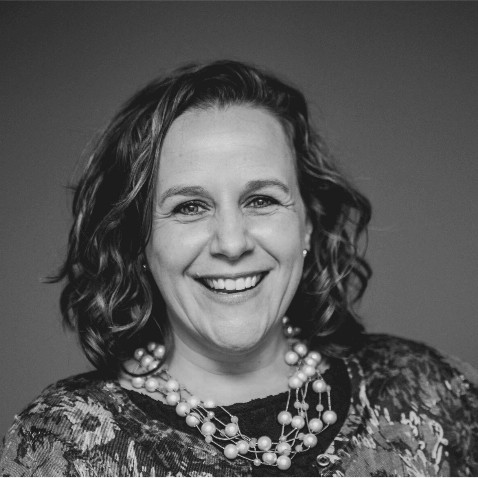
I am approaching my 4 year anniversary with CareSource, a non-profit Managed Care Organization that covers nearly 2 million members that live in Ohio, Indiana, Georgia, West Virginia, and Kentucky. Since the beginning, I have been a part of the Life Services team, which is focused on the integration of the social determinants of health into all lines of our business.
CareSource is my first role within the Medicaid industry. Prior to CareSource I had worked in multiple roles that helped improve communities for individuals living in poverty. My work included education, strategies to end homelessness, and revitalizing communities after the housing crisis. When CareSource started Life Services they took the bold approach to hire experts from outside of the Medicaid industry – I am very thankful for that innovative vision. I jumped into my new career and have been learning something new every day. After four years I can now speak “fluently” housing and healthcare.
Personally and professionally my passion is for building communities through the lens of where we live. At work, I have the opportunity to create strategies to increase the availability and affordability of housing for our members. I love every aspect of this work, especially the fiscal and social policy related to affordable housing. Public housing benefits are incredibly different from health coverage – the contrast of the two create the perfect playground for my mind to work. Personally, my husband and I also rehab historic homes. Helping to bring new life to a beautiful old structure is immensely gratifying.
Almost all of my “bucket list” items are focused on traveling. I love to explore new places near and far. In the United States, I am getting closer to reaching my goal of visiting all 50 states and every National Park. My favorite travel spots to date are watching the sun rise from Haleakala National Park in Maui and hiking Bryce Canyon National Park in Utah. On the top of the list for places that I want to visit is Denali National Park in Alaska. I also love to travel abroad, right now Italy is at the top of that list.
Currently, my free time is consumed by my three young daughters. Our nights and weekends are filled with school and sporting events. I enjoy being involved in their activities either on the sidelines cheering, helping them master a new skill, or volunteering annually as the Girl Scout Cookie Mom. Our lives can be very hectic but it is amazing to see the world through their eyes.
I was an Accounting major in college, until my first Political Science class when I learned about Archbishop Desmond Tutu and the South African Truth and Reconciliation process after the end of Apartheid. His work and steadfast belief is advocating for what is right, no matter the consequences, became a guiding light. He was a mediator, influencing others by helping them to find understanding, rather than trying to force his viewpoint. He helped people to find peace within the political system and within their hearts. I graduated with the degree in Political Science and embarked upon my career with the intention to help the world heal from the wrongs of the past and build just societies.
Hands down – a brownie. I can skip most sweet temptations but I can’t say no to a brownie.
Being a mom to my three daughters is truly my greatest accomplishment. I faced many challenges on the journey to becoming a mother, but the process made me stronger and more resilient.
I believe that everything happens for a reason, and no matter the outcome, it is what you learn from the situation. I have not always made the best decisions and there are many things that did not turn out the way I wanted, but it is the success and the failure that has brought me to this point. For the important moments and decisions, there is nothing that I would do over.
Of course, the social determinants of health. I believe that we are starting to understand how to address social needs within the structures of MCOs or health providers. The healthcare system has an infrastructure that can help to facilitate the delivery of interventions and services. If we can build strong relationships with community based organizations we will have the ability to comprehensively address individual social needs. This work is essential, we must double down and take it to scale. However, the most important part is the next step – we must start to dismantle the systemic constructs that create the social need. We must get upstream. For an example – there are programs that serve homeless members and help them find housing. We have programs at CareSource, other MCOs and Hospital Systems across the nation are also creating programs. In the next 6 months we must start talking about why people are becoming homeless, how we prevent homelessness, and how do we screen for housing instability. The health and financial outcomes will come from curing the social issue, not treating it.
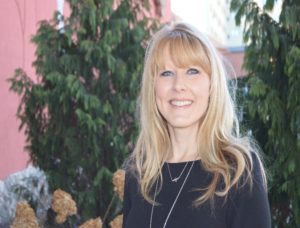
I currently work in the Steele Institute of Innovations under the health pillar for Geisinger Health System. Geisinger is an integrated care delivery system in rural Pennsylvania serving over 3 million patients in 45 counties.
I have been involved in the Medicaid industry all of my professional career, which has been 25 years now.
My biggest focus as well as passion as a nurse, is addressing population health needs. I am particularly interested in just how profoundly social determinants of health has on one’s chronic disease. Its enlightening to see health care taking an interest in this space.
I don’t really have a bucket list. I try to live each day to the fullest and appreciate life events both big and small, good and bad. I feel incredibly blessed to be living this life however If I had to choose something that would be considered a bucket list item, I suppose I would say a big family vacation to somewhere like Ireland to better appreciate the beauty in our Irish heritage.
Spending quality time with my family and friends. The older I get I realize just how important time is. It seems like only yesterday my children were babies however they are far from it. My son just turned 20 and my daughter is 18. Time certainly waits for no one. Outside of quality family time, I enjoy baking and crafting.
I would have to say Florence Nightingale. As the founder of modern nursing, her accomplishments in providing quality care while reducing mortality rates forever changed the role nurses played in healthcare.
Pizza…Breakfast, lunch, or dinner-anytime is a good time for pizza!
Personally, I am incredibly proud of my children. They are humble, kind, bright, and passionate young adults with a ton of ambition.
Professionally I am proud of the innovative programs that Geisinger has developed over the years to better care for the patients entrusted to us. There is no greater gift than caring for patients and being able
to meet their needs.
If ever given a second chance, I would ask to rewind the hands of time. There were so many “little” things taken for granted, so many missed opportunities to say thank-you for everything, to show appreciation for nothing, and to
acknowledge something.
Use of artificial intelligence
Expanded focus on SDOH
Greater emphasis on wellness and prevention
Know someone in the space who’s doing great work and is an all around interesting person?
Send a note to clay@mostlymedicaid.com to nominate them for the next round of Medicaid Industry Who’s Who Interviews
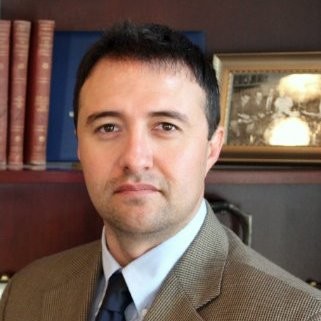
Healthcare, Medicaid Industry.
7 years.
Social determinants of health, K-12, and higher education equity.
After traveling to 6 of the 7 continents, my top bucket item is to visit Antarctica.
Traveling, exercising, and Fútbol (Soccer).
Cesar Chavez, advocate for farm workers. My family also worked the fields in rural Colorado.
Any and all desserts.
Completing my Ph.D.
Spending more time with my grandparents in Mexico.
a. Behavioral Health Integration
b. Social Determinants of Health
c. Medicare for all
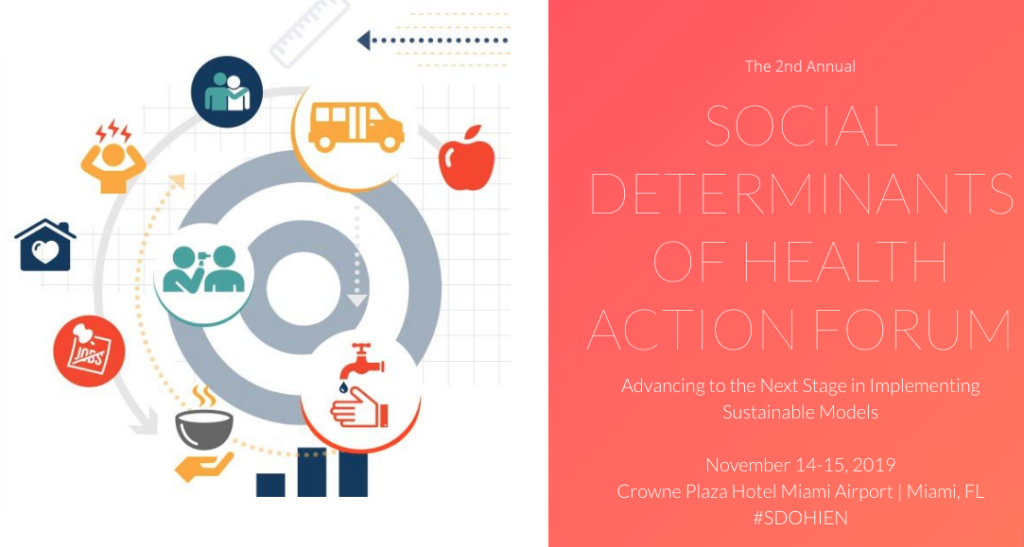
Know someone in the space who’s doing great work and is an all around interesting person?
Send a note to clay@mostlymedicaid.com to nominate them for the next round of Medicaid Industry Who’s Who Interviews
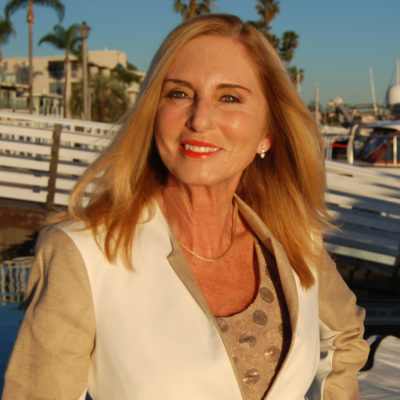
I am currently working in the “medical and social integration” space as a consultant to build bridges and integrate our silos. My focus is connecting health plans, health systems and providers (medical, LTSS and SDOH, as well as affordable housing), to create person-centered care that focuses on the holistic needs of Medicare and Medicaid beneficiaries. This involves the creation of innovative and common-sense solutions and interventions that improve the quality of care and lives of older adults, people with disabilities, the institutionalized and people experiencing homelessness. This sometimes also involves writing funding proposals to launch innovative models and expand Medicaid and existing programs into new markets.
My focus has been on Medicaid-eligible individuals for over 20 years, although I began working with older adults as a nurse aide at the age of 14 at a Medicaid-financed nursing/rest home in upstate New York. I segued into law and became a paralegal for several years, which gave me a strong foundation for creating partnerships. After a 97-year old extended family member, who I was caring for in my home, passed away, I was drawn back into working with older adults, and volunteered as an LTC Ombudsman while I was getting my Master of Science degree in Gerontology.
SCAN Health Plan engaged me immediately after graduation, and I realized that I could impact older adults and people with disabilities in a greater way by helping develop Medicare Special Needs Plans (SNPs) and building community outreach teams to enroll economically disadvantaged beneficiaries. I ended up founding a senior housing company in the late 1990s to provide contract service coordination so low-income affordable housing residents could receive services and continue to age-in-place (primarily Medicaid and duals). After serving as Executive Director of an Area Agency on Aging (which are federally mandated to assist older adults with the greatest needs, with an emphasis on low-income ethnic minorities), I realized how fragmented and duplicative our systems are and began focusing on integration.
For the past 16 years, I have served as an Executive Advisor, Vice President of LTSS and Consultant, to health plans and other providers, focusing on integrating Medicare Advantage, SNPs and Managed Medicaid plans with social services providers by building networks, negotiating contracts and launching innovative pilots and community partnerships.
I was fortunate to discover my passion for older adults as a teenager, and to spend most of my life working to improve their quality of care and lives. Helping organizations serving people experiencing homelessness is a more recent passion, especially since the number of older adults experiencing homelessness is continuing to rise at an alarming rate. I miss working with older adults directly; however, I am grateful that I can impact their lives by focusing on improving access to care and much needed social supports.
Continuing to travel to countries not only to see tourist sites, but to also learn how they are caring for their most vulnerable populations. We can learn a lot from what others are doing in the space.
I love to travel, and it’s a special treat when I can combine travel and my passion for older adults and see how they are living and being cared for in other countries. Some of my favorite places have been Peru, Thailand, Argentina, and Italy. I also enjoy spending time outdoors with my partner, family and/or friends – hiking – especially in Sedona, the Eastern Sierras and Utah Parks, walking on the beach or in the woods, biking, kayaking, skiing and dancing. I went sky diving once and would love to do so again. I also enjoy quiet evenings, going out to dinner and to concerts, and reading historical novels and autobiographies.
There are so many famous and not-so-famous historical figures that I admire, especially those who took great risks to improve the lives of those less fortunate than themselves. A current individual whom I greatly admire is Supreme Court Justice Ruth Bader Ginsberg. I have a tremendous amount of respect for those who speak on behalf of and do for those who cannot do for themselves.
Chocolate!
On a personal level, I am most proud of my two daughters, who have evolved into amazingly strong and talented young women. Professionally, I am proud and grateful to be able to work with leaders running health plans and systems, social services organizations and affordable housing companies who have and continue to give me opportunities to serve our vulnerable populations. I view our siloed systems from 30,000 feet, and see people, companies, and programs that could and should be connected. Some of those projects include integrating a health plan with an Area Agency on Aging (AAA), an Independent Living Center (ILC), a Long-Term Care Ombudsman program (LTCOP) and a Recuperative Care facility for people experiencing homelessness who need a place to heal following hospitalizations.
If I was given the opportunity to run another government agency, I would take a more measured and incremental approach to changing systems. I would spend more time listening to the individuals who have worked in that space for many years and ensure key stakeholders are on board with the changes before agreeing to such a large restructuring. Too many strategic plans and innovative programs are created that are not sustainable because of politics and resistance to change.
We are living in exciting times – the health care industry has awoken to the fact that continuing to spend money on medical care without looking at patients’ social determinants needs is like throwing money into a black hole. If we’re going to bend the cost curve on health care, we need to:
Get physicians and the entire medical community on board with looking at the whole person, and to play a key role in ensuring patients have access to critically needed social services and support that positively impact their health.
Continue to innovate to address Social Determinants of Health needs
Develop technology platforms that are interoperable and allow beneficiaries, their caregivers, and all their providers, whether medical, behavioral/mental health, social community-based services, long term care, etc., to view and share data to ensure people are getting the right care, at the right time, in the right place.

Know someone in the space who’s doing great work and is an all around interesting person?
Send a note to clay@mostlymedicaid.com to nominate them for the next round of Medicaid Industry Who’s Who Interviews
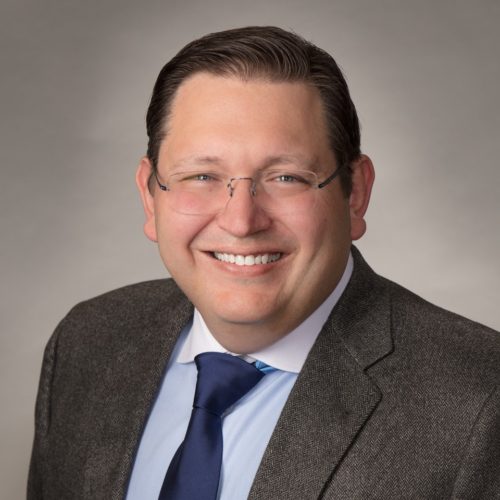
I currently work in health philanthropy. As President and CEO of the de Beaumont Foundation, I am fortunate to touch many different areas, including the government public health workforce, partnership development with multisector collaboratives, and policy work. Previously, I spent a decade working in state and local health departments.
I actually have never been in Medicaid, but public health and Medicaid are intimately related. In my past roles as a public health leader, several programs that I oversaw had direct links to Medicaid.
Besides my family, Patriots football, and NC State Wolfpack football, I am super passionate about changing communities so that everyone has their best chance at achieving their optimal health. When we say that your zip code has more impact on your health than your genetic code, we are essentially pointing out that we are playing a rigged game – a game that benefits those with and in power at the expense of the poor and vulnerable. That’s not the world I want to leave to my kids.
Personally, I would like to spend some time whale watching in the waters off Seattle. Professionally, the top item is helping transition our national conversation from a focus on healthcare and insurance to one that considers health more holistically.
Of course, spending time with my kids (Evan, 10, and Chloe, 8). As nerdy as this may sound, I also love to write – blogs, books, journal articles, tweets. Sharing ideas is so important, and the Internet and social media have made sharing our ideas so much more egalitarian. Using these tactics effectively is especially important in public health settings: social media gives our field the chance to counter misinformation, engage people and communities directly, and share new findings.
Jimmy Valvano, head basketball coach at NC State from 1980 to 1990. Jimmy V was the consummate underdog – winning the 1983 NCAA basketball championship against all odds. His subsequent battle with cancer led to the creation of the V Foundation. At his last public appearance before his death at the 1993 ESPY Awards, he said something that I have thought about almost every day since: “If you laugh, you think, and you cry [every day], that’s a full day. That’s a heck of a day. You do that seven days a week, you’re going to have something special.”
Pepperidge Farm coconut cake. My wife hates it, but it was something special that I would get at my maternal grandmother’s house when I would visit as a child. So, it may be the memories that are satisfying more so than the cake. But if the Pepperidge Farm people read this and want to send one over, I wouldn’t object.
I am most proud of the opportunity I was given to lead the de Beaumont Foundation. Our founding CEO (retired) and Board Chair, James Sprague, was personally entrusted with Pete de Beaumont’s estate upon his passing. Jim has had a role with the Foundation since before it even began, more than 25 years. It was truly an honor to assume the role of President and CEO of de Beaumont and have a role in this amazing Foundation.
Nothing. Always hit the ball where it lies. You never know what will happen next. I’ve had success. I’ve had failures. I’ve made good decisions and bad. Each and every one got me to where I am now, and I wouldn’t trade that for anything.
Medicaid will need to expand its allowable costs and broaden its investments. Bugs and bacteria aren’t driving costs anymore. Today, the major contributor of ill health is the lack of strong foundations for community health – housing, food, income equality, education access. Medicaid will need to consider how to address patients’ social needs as part of restoring their health. Related, Medicaid continues to be the largest single line item in most state budgets. Legislators who are concerned about the growing cost burden of Medicaid need to focus on policies that create the environment where everyone can be healthy. Focusing simply on why Medicaid recipients are unhealthy and paying for their healthcare is like feeding the fish but not cleaning the tank. Cost-effective programs that set people up for a lifetime of health, like high-quality, affordable early childhood education, are a key part of this.

Know someone in the space who’s doing great work and is an all around interesting person?
Send a note to clay@mostlymedicaid.com to nominate them for the next round of Medicaid Industry Who’s Who Interviews